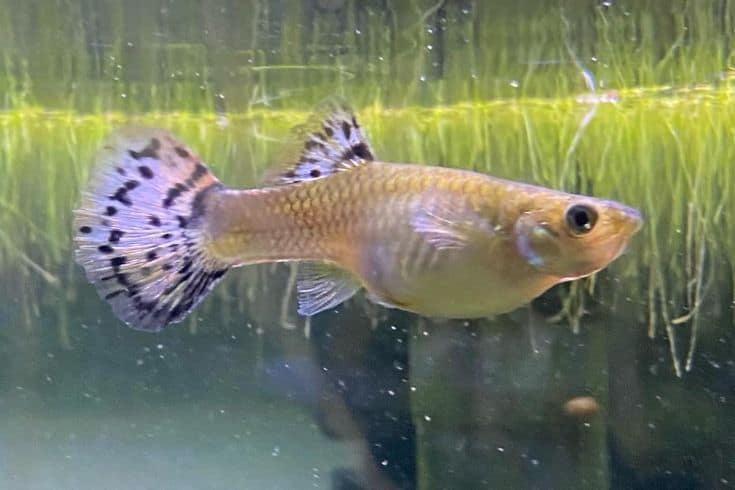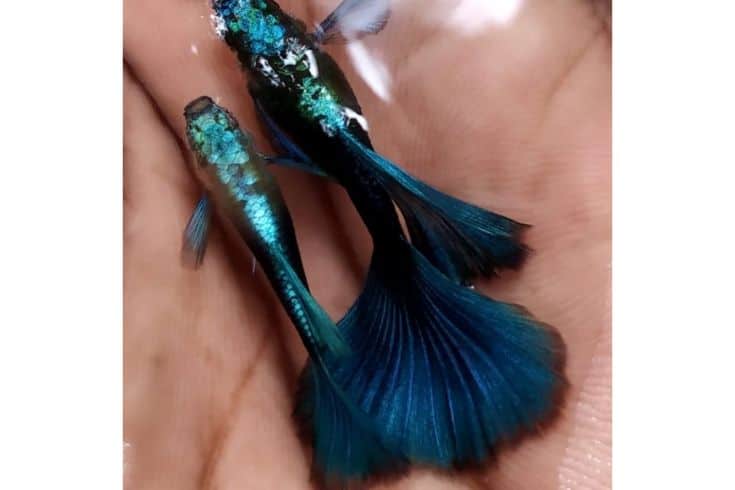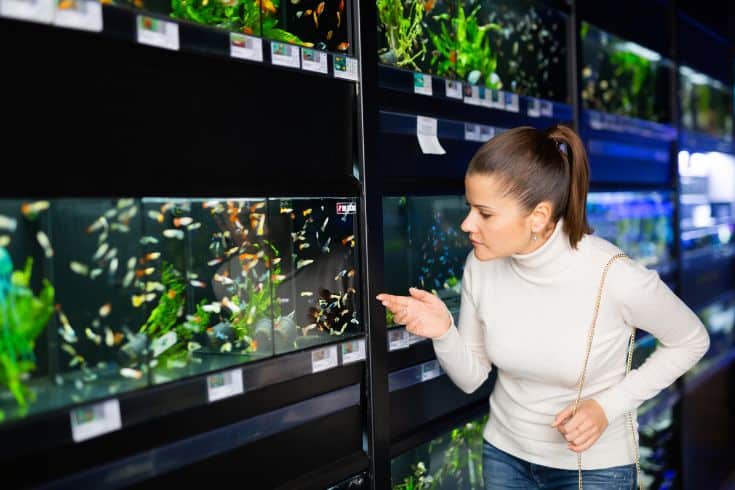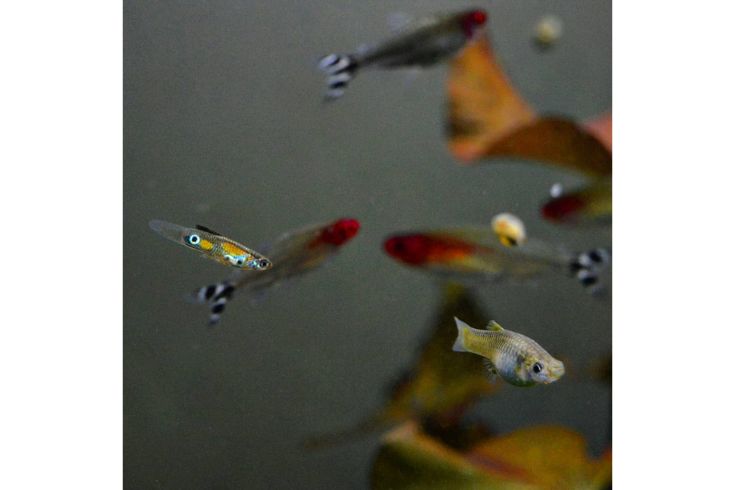Guppies are known for their stunning colors, but they’re also one of nature’s most prolific breeders. For most fishkeepers, this is good news – you can enjoy watching generations grow up under your care. Unfortunately, uncontrolled breeding can lead to overcrowding and water quality issues, so it’s important to learn how to stop guppies from breeding if necessary.
In this guide, we’ll cover the best methods for curbing your guppy population growth. We’ll also talk about some common reasons why these birth control measures fail, as well as provide some guidance on what you should do in these cases. By the time you’re done reading, you’ll have all the tools you need to control your guppy population.
Understanding Guppy Breeding (and Overbreeding)
Before delving into how to stop guppies from breeding, it’s important to understand the basics of how and why guppy breeding occurs. Guppies are live-breeder species, which essentially means they give birth to live young. Livebearers like guppies and mollies can give birth up to 6 times from a single encounter with a member of the male species and produce up to 100 fry in a single batch.
While useful in ensuring the species’ survival in the wild, this trait can quickly lead to the uncontrolled breeding of guppies. Again, this doesn’t pose a problem in the wild, where food is plentiful and predators control the population. However, in an aquarium setting with plenty of food, there are few natural checks on breeding activity.
One of the biggest consequences of an unchecked guppy population boom is overcrowding. When too many guppies are present, the oxygen levels and water quality of a tank quickly deteriorate. This is largely due to the increased waste production – the amount of ammonia produced by your guppies exceeds what can be processed by the biological filter.
How To Stop Guppies From Breeding
Given that guppies breed quickly and often, it’s important to know how to stop guppies from breeding if necessary. Here are some of the most effective methods:

Keep Males and Females in Separate Tanks
Our first suggestion is also the most intuitive. Any kind of breeding activity and fertilization can only occur in a mixed-gender tank, so keeping males and females apart is the best way to ensure they don’t breed. In practice, this means you’ll use no longer have one standalone guppy tank. Instead, you’ll have a female-only tank, and another one just for males.
You’ll want to separate your guppies as soon as they become sexually mature – around 8 weeks of age. Sexual dimorphism, or the differences between males and females, also becomes apparent during this time. Males will display a brighter range of colors than females, as well as larger tail fins. These traits make for flashier fish, but they also act as a handy way to attract mates
Females, on the other hand, have shorter tail fins and muted colors. Again, these traits have a purpose: they make it hard for predators to spot a female guppy, particularly when they’re pregnant. Given that females do not need flashy colors to attract a mate, the ability to stay hidden and ensure the safety of their fry is essential.
Feed Your Guppies A Little Less
We’ve now ventured into a more indirect approach to keeping guppies from breeding. Many aquarist community forums recommend slightly decreasing the amount of food you feed your guppies. This idea holds that by limiting resources, you can reduce their energy levels and, in turn, their desire to breed.
We suggest decreasing your guppy’s food intake by about 15-20%. This will ensure they get the essential nutrition they need, while also preventing overeating and, as a result, overbreeding. People who want their fish to breed tend to increase the food rations, so going the opposite way can help keep your population in check.

Of course, we need to stress the importance of being vigilant when it comes to reducing food intake. Guppies need a substantial amount of nutrition to stay healthy, so make sure your feedings are still consistent, and that your fish are getting the energy they need. Keep a careful eye on your guppies, and adjust the food accordingly.
Lower Water Temperatures (Slightly and Gradually!)
Guppies generally thrive in water temperatures between 72-82°F. However, the ideal range for breeding and fry production hovers around 78-80°F. If you lower the temperature in your guppy tank, it can reduce their energy levels and, by extension, their desire to breed. Keeping your water temperature between 72 to 75°F is a great way to discourage breeding behavior.
That said, it’s important that you lower the temperature gradually. Aim for a decrease of 1-2°F per day, and don’t drop the temperature directly to the ideal range all at once. Doing so can shock your guppies and cause them to become stressed, so gradual adjustments are important.
Due to the specificity required of this method, it’s recommended that you consult a thermometer for accuracy. This will help you keep a close eye on the temperature in your tank and ensure you stay in the desired range. A heater with an adjustable thermostat can also be handy for maintaining the ideal temperature.
My Guppies Gave Birth Anyway – What Happened?
The measures we covered are all great ways to keep your guppies from breeding, but they are not foolproof. Many things can go wrong, and despite your best efforts, your fish may still manage to find a way to spawn. Though this isn’t the end of the world, understanding the underlying causes can help prevent future surprises. Here are some of the most common reasons:
Female guppies store sperm in their bodies
Female guppy fish are able to store sperm in their bodies for up to three months, depending on the species. This means that even if a female guppy has not been in contact with a male for an extended period of time, they may still be able to become pregnant. And they can do this over and over – female guppies can give birth up to 6 times after a single encounter.
What does this mean in practice? Well, if you’re a fishkeeper who has separated your male and female fish in an attempt to prevent breeding, it’s important to keep track of how long the separation has been in place. If a female guppy has been separated from her male mate for more than three months, it’s likely she no longer has sperm stored in her body.
On the other hand, if the separation has only been in place for a few weeks or months, it’s possible your female guppy could still become pregnant and produce fry – even without male contact. If this is indeed the case, all you can do is wait it out. In the meantime, be sure to separate the fry from their parents, and separate the genders as early as possible.
Males and female guppies weren’t properly separated
The next big cause of unexpected accidents has to do with the misidentification of gender. It can be hard to tell the difference between male and female guppies, especially for first-time fishkeepers. It takes a trained eye to notice the subtle differences in coloration and tail length that are so characteristic of each sex.
If you are attempting to separate the genders, make sure you properly identify each fish as male or female before separating them. If you can’t tell with certainty, it’s best to err on the side of caution and consult a professional who can help. These people will be able to point out the subtle differences between male and female guppies, so you know exactly what to look for.
It’s also important to keep an eye on your fish after you’ve performed the separation. Guppies are tiny little creatures that can hide in the tightest of places, so it’s possible that one or two may slip through the cracks and end up in the wrong tank. If this happens, your fish could still breed – despite your best efforts.
The female was already pregnant
Last but not least, many aquarium owners miss one important detail – the fact that their female guppies were already pregnant. In the early stages of pregnancy, it’s difficult to tell that a female guppy is expecting. The belly won’t swell until the final stages, and it can be easy to miss if you’re not paying constant attention.

One of the key signs of a pregnant guppy is a darkened gravid spot – this is a black discoloration that appears on the underside of the female’s belly as she prepares to give birth. If you notice this, it means your female guppy has already spawned and is carrying fry in her body. This gravid spot grows larger as the pregnancy progresses, so keep an eye out for it.
It is also helpful to note any changes in behavior. Females that are about to give birth may exhibit strange behaviour, such as swimming erratically or hiding in dark corners of the tank. If you notice these changes, it may be time to take a closer look at you fish, and move the pregnant female to a birthing tank to keep her comfortable.
What To Do With Unwanted Guppy
No matter what caused the unexpected breeding, it is important to have a plan in place for the unwanted fry. If you are unable to provide them with proper care, they will suffer and may even die. Here are some tips to help you decide what to do with the extra guppies
Give Them Away
Of the wide range of options available, giving the fry away to other fishkeepers is one of the most humane. If you know anyone who loves guppies, you can offer them up as a gift – or alternatively, look for local pet stores or aquarium clubs that might be willing to take them in. Guppies make lovely gifts for fish enthusiasts, regardless of age or experience.
While it can be tempting to give your fish away to the first person who shows interest, it’s important to make sure they will be taken care of properly. Find out as much as you can about the recipient before handing over your fish – this will help to ensure they are going to a safe and loving home. Even if this takes a little more time, it’s well worth the trouble.

To help with the transition, make yourself available to answer any questions they have and offer guidance on how to care for the new guppies. Offer to provide some water and food from your own tank if possible, to help the new owners get started. The best part of giving them away is being able to connect with a fellow fish lover – so take a moment to enjoy this experience!
Donate Them To A Research Facility
Another option is to donate your unwanted fry to a research facility. This puts them in the hands of experts who can use their knowledge and experience to properly care for the fish. It’s also a great way to help support scientific research (here’s an example) – which is becoming increasingly important in today’s world.
Before donating your fry, contact the facility ahead of time and find out what they need from you. Most facilities require certain information about the guppies before accepting them – such as age, sex, and any genetic characteristics that may be present. Be prepared to provide this information when making the donation.
It’s also important to take some time to ensure the facility provides quality care for its inhabitants. Make sure there are enough tanks and personnel to properly look after the fish – and that they follow a strict cleaning regimen. You can usually find this information online or by speaking with the facility directly.
Once you have found a suitable facility, transport your fry there in a sealed container filled with tank water from their original home. This will help ease the stress of relocation and give them the best chance at adjusting to their new environment.
Sell Them To Local Pet Stores

Another easy way to get rid of your extra guppies is by selling them to local pet stores. This is an ideal option if you don’t know anyone who would like to take your fish off your hands – plus, it’s a great way to make a little extra money in the process.
To start, contact your local pet store and inquire about their guppy sales policy. Make sure to ask what kinds of fish they accept and any other requirements that need to be met before making a sale. Gathering this information ahead of time will help you determine if selling them is the right choice for you.
Once you have established that selling is an option, determine how many fry are ready for sale – then separate them into individual bags or containers, with enough water from the original tank to keep them comfortable until they reach their new home. Make sure to label each bag or container clearly with species name and age, so the pet shop knows exactly what they are buying.
Feed Them To Other Fish
This last approach may sound a little cruel at first, but is actually one of the most practical ways to deal with unwanted guppies. In nature, guppies are at the bottom of the food chain and are eaten by larger fish – this is why they have evolved to breed so easily and in such large numbers.
If you have larger predatory fish in your tank, donating your excess guppies to them can give them a healthy, natural snack – plus, it helps keep the population of your tank in balance. When feeding them to other fish, make sure that you only add a few guppies at a time – this will help prevent them from being overwhelmed by the sudden influx of food.

No matter which option you opt for, it’s important to do right by your fish and treat them humanely. Guppies make great companions, so it’s important to give them the love and attention they deserve – even if you don’t want them around anymore.
The Takeaway
While unexpected guppy breeding can be a surprise, it doesn’t have to be a disaster. With proper preparation and caution, you can easily manage the population in your aquarium and avoid future accidents. Remember to separate genders as early as possible, keep an eye out for changes in behavior, and if all else fails, consider giving away or selling the extra fry.
Did you enjoy learning about how to stop guppies from breeding? Please share this article with your friends and family so that they can benefit from this knowledge, too. Thanks for reading!
